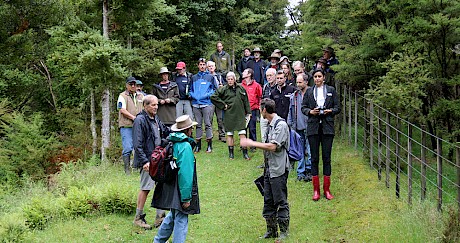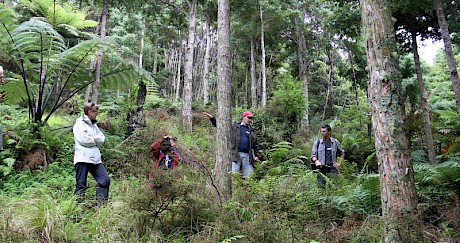Tanekaha (Phyllocladus trichomanoides)
History
The Maori made fairly extensive use of tanekaha. The double pointed spear, koi koi which was about two metres long was made of tanekaha, doubtless because it is one of the strongest and most flexible native softwoods. Other Maori uses were in canoe and house structure and the bark was used as a source of red dye. Tanekaha was also used medicinally by the Maori, as a liver tonic and treatment of dysentery and vomiting. Early European use was as sleepers, marine piles and pit props. Its strength meant it was also useful for bridge decking and heavy roof timbers. Its properties also made it a useful wood for agricultural machinery like hay sweeps. Occasionally joinery was also made from tanekaha.
Distribution
Tanekaha is a warm temperate species mostly confined to the North Island, north of a line from Mokau to Mahia Peninsula (latitude 39°). It is also found in isolated locations in northern Nelson and Marlborough. The species grows on a wide range of soils, preferably well drained lowland alluvials or moisture retentive pumice. It is intolerant of poor drainage, especially on flat sites and requires reasonably high moisture level for good growth. On dry ridges in the north, tanekaha is a common pioneer species but never grows into a large tree. It grows well in scrub with overhead light.
Tree size and growth
Tanekaha grows to just over 20 metres tall and up to one metre in diameter. Growth rate in the few trials that have been done suggest that it is slower than kauri, reaching only 14 metres in height and 27 cm in diameter at 50 to 60 years. It is unlikely that the sites on which these plantings were planted are optimum for the species; if so fertile and well watered sites should produce faster growth.
Timber
Tanekaha wood is described as having well defined growth rings, whitish sapwood and orange-brown heartwood. The texture is fine and even and the figure lustrous. The timber is easy to air dry and moderately ground durable (10 – 15 years). It saws, machines and turns very well and takes a fine finish. Of all the native softwoods it is the strongest and most flexible. Timber characteristics, with P radiata figures shown in brackets for comparison, are as follows:
Density: 610 kg/ m³ (500 kg/m³ )
Moisture content: green 100% (130%)
Tangential shrinkage - green to 12% m.c 3.6% (4.7%)
Radial shrinkage 1.4% (2.2%)
Modulus of rupture 106 Mpa (90 Mpa)
Modulus of elasticity 11.4 Gpa (9 Gpa)
Potential
Tanekaha, because of its high quality, deserves much more attention as a useful New Zealand timber species. In the north it regenerates profusely in association with kauri under manuka/kanuka nurse. Initial growth rates appear to be quite fast. However these sites, usually ridges and spurs, are frequently too dry in summer which appears to restrict growth. In this situation the species reaches little more than 15 metres tall and 30 cm diameter and the timber is prone to shakes. The occasional tanekaha growing in gullies adjacent to ridge sites can reach double the diameter, suggesting that moisture is a governing factor as far as good growth is concerned. If the optimum growth conditions for tanekaha can be determined it is expected that faster growth and better wood quality will result.
Research requirements
Main effort needs to be directed at determining the correct site conditions for optimum growth.
References
- Allan H H 1961. Flora of New Zealand Vol. 1 Government Printer Wellington
- Brooker S G, Cambie R C & Cooper R C 1981. New Zealand Medicinal Plants. Heinmann
- Burstal S W & Sale E V 1984. Great Trees of New Zealand
- Clifton N C 1990. New Zealand timbers
- Hinds H V & Reid J S 1957. Forest Trees and Timbers of New Zealand. Govt Printer Wellington
- Pardy G F, Bergin D O & Kimberley M O 1992. Survey of Native tree plantations. FRI Bulletin 175
Species profile by Ian Barton


